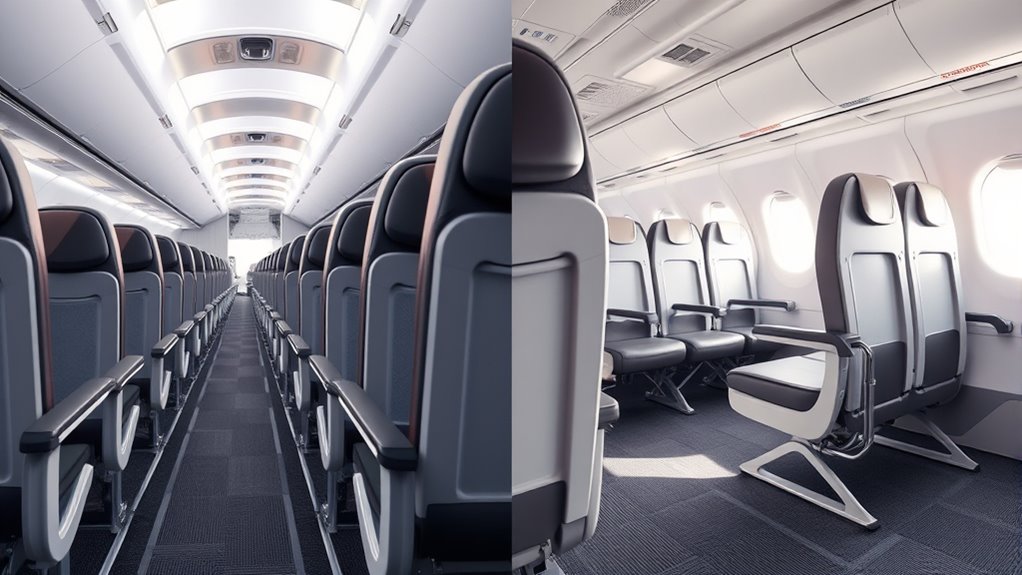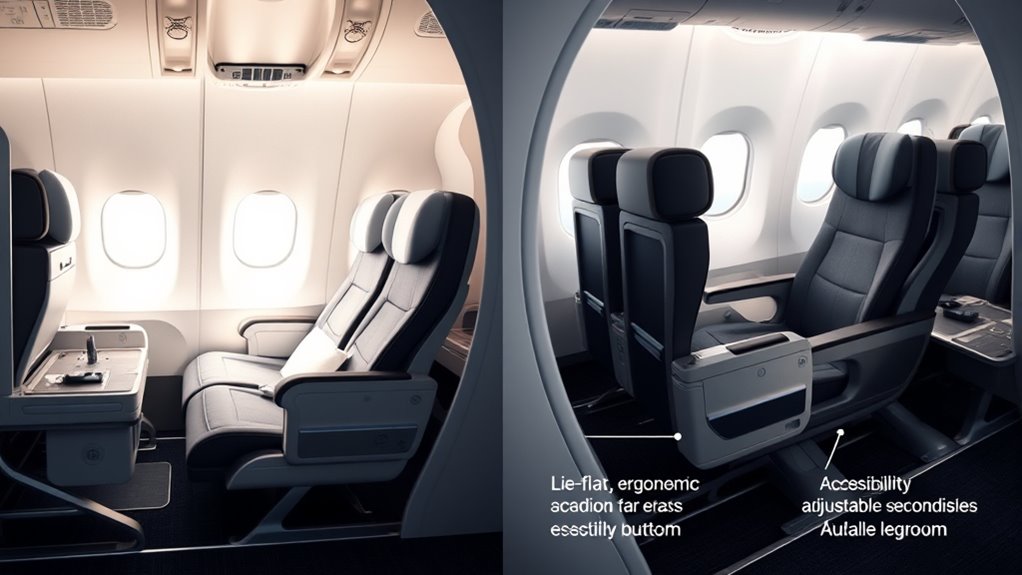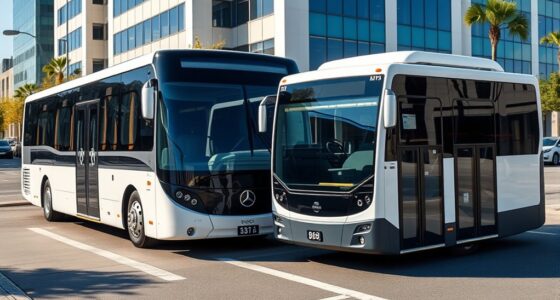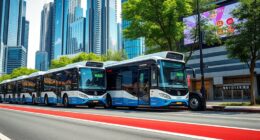To maximize your comfort, compare seat layouts and accessibility features like aisle width, recline options, and legroom before booking. Wider aisles make movement easier, especially if you have mobility needs, while seats near exits or bulkheads often offer extra space. Consider your priorities, whether it’s quick access, scenery, or extra legroom. Exploring these details helps you choose the most suitable seat for a more relaxed flight—keep exploring to discover even more tips.
Key Takeaways
- Assess aisle width and layout variations to ensure ease of movement and accessibility throughout the cabin.
- Compare seat recline options to select seats that offer optimal comfort for the entire flight duration.
- Identify seats near emergency exits or bulkheads for extra legroom and accessible features.
- Review aircraft-specific accessibility features like wider aisles, adjustable armrests, and space for mobility aids.
- Research airline seat maps and accessibility options in advance to choose the most comfortable and convenient seats.

When choosing a seat, understanding the layout and accessibility features can make your travel experience much smoother. A key consideration is aisle spacing, which directly impacts your comfort and ease of movement during the flight. Seats with generous aisle spacing allow you to stretch your legs, get up without disturbing neighbors, and access the aisle swiftly. If you value extra room or have mobility concerns, look for aircraft with wider aisles, especially in premium cabins or at exit rows. Additionally, seat recline is essential for relaxation on longer journeys. Some seats offer minimal recline, while others provide a more substantial backward tilt, helping you rest better during the flight. Be aware that seats close to the lavatories or galleys might have limited recline or be subject to noise and foot traffic, which can affect your comfort.
Understanding the differences in seat layouts can help you choose the most suitable seating arrangement. For example, an economy class seat near the emergency exit often provides more legroom and sometimes a slightly reclined seat, but these seats may come with restrictions, such as limited recline or additional responsibilities in emergencies. On the other hand, bulkhead seats are positioned at the front of a cabin section, offering extra legroom and often more accessible features, but they might have fixed armrests or limited under-seat storage. Aisle seats are perfect if you prefer quick access to the aisle and more freedom to move around, especially on long flights. Window seats, meanwhile, are ideal if you want to enjoy the view and have a wall to lean against, but they might offer less aisle space and limited recline compared to middle or aisle options.
If accessibility is a priority, many airlines provide specific features such as wider aisles, adjustable armrests, or seats with extra space for mobility aids. Some aircraft are designed with these features in mind, making boarding, deplaning, and moving around easier for passengers with disabilities or limited mobility. When selecting your seat, check the airline’s seat map and accessibility information beforehand, since layouts vary considerably across aircraft types. If you need additional accommodations, don’t hesitate to contact the airline directly to ensure your needs are met. Being proactive about understanding aisle spacing and seat recline options not only enhances your comfort but also minimizes stress during your journey. Recognizing aircraft seat layouts can significantly improve your overall travel experience by helping you choose the best possible seat for your needs. Ultimately, a little research and planning can turn a potentially uncomfortable flight into a more relaxed and enjoyable experience.
Frequently Asked Questions
How Do Seat Layouts Affect Passenger Privacy?
Seat layouts considerably impact your privacy by influencing passenger separation. When seats are arranged with more space or partitions, your seat privacy improves, giving you a sense of personal space and reducing distractions. Conversely, closely packed layouts may compromise passenger separation, making it harder to enjoy privacy. Choosing a layout with thoughtful seat separation features helps you feel more comfortable and maintains your personal space during the journey.
Which Accessibility Features Are Most Effective for Elderly Travelers?
You should prioritize accessibility features like Braille signage and visual alerts, as they’re highly effective for elderly travelers. Braille signage helps those with visual impairments navigate easily, while visual alerts ensure they stay informed about important announcements or emergencies. Combining these features creates a safer, more comfortable environment, allowing elderly passengers to travel with confidence and independence. Your focus on these elements considerably enhances their overall journey experience.
Are There Universal Design Standards for Airline Seat Accessibility?
You’ll find that universal standards and design guidelines do exist to promote accessible airline seating, making travel smoother for everyone. These standards aim to create a consistent, user-friendly experience across airlines, ensuring seats are adaptable and easy to access. While not all airlines follow a single set of rules, many adhere to international or regional guidelines, helping you feel more comfortable and confident when flying.
How Do Seat Configurations Impact Overall Travel Safety?
Seat configurations directly influence your travel safety by affecting seat safety and how well passengers can evacuate in emergencies. A well-designed layout minimizes obstacles and guarantees clear pathways, making it easier for you to move quickly if needed. The layout influence extends to the placement of seats, seat belts, and safety equipment, all of which contribute to a safer flying experience. Always choose seats with ideal safety considerations for peace of mind.
What Innovations Are Upcoming in Seat Design for Comfort?
Stay ahead of the curve with upcoming seat innovations focused on comfort. You’ll see smart materials that adapt dynamically to your body’s needs, providing personalized support. Ergonomic adjustments will become smarter, offering tailored lumbar support and adjustable headrests for ultimate relaxation. These innovations aim to enhance your travel experience by combining cutting-edge technology with clever design, ensuring you arrive refreshed, relaxed, and ready to go.
Conclusion
By choosing the right seat layout and accessibility features, you can greatly enhance your travel experience. Did you know that 85% of passengers feel more comfortable when seating options accommodate their needs? Prioritizing these features ensures a smoother, more enjoyable journey for everyone. When you consider accessibility and thoughtful design, you’re not just selecting a seat—you’re creating a more inclusive, comfortable environment for all passengers to relax and arrive refreshed.









